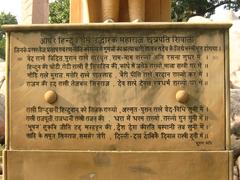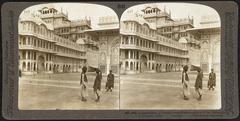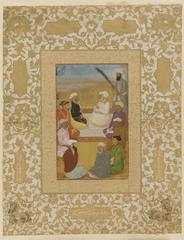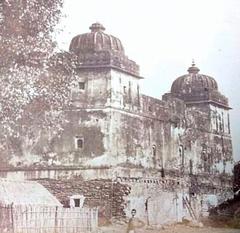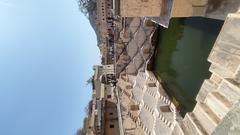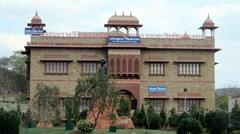Patrika Gate Visiting Hours, Tickets, and Historical Significance
Date: 17/07/2024
Introduction to Patrika Gate
Jaipur, often referred to as the ‘Pink City,’ is renowned for its vibrant history, stunning architecture, and rich cultural heritage. Among its many attractions, Patrika Gate stands out as a relatively new yet profoundly significant addition to the city’s architectural landscape. Constructed in 2016 by the Patrika Group, one of India’s largest media conglomerates, Patrika Gate serves as an entrance to the Jawahar Circle Garden, which is one of the largest circular parks in Asia. The gate was built to pay homage to the diverse and colorful heritage of Rajasthan, encapsulating the essence of the state’s architectural and cultural traditions (Rajasthan Tourism) (Jaipur).
Patrika Gate is a visual feast, characterized by its intricate carvings, vibrant frescoes, and detailed murals that narrate the history and traditions of Rajasthan. Each pillar and section of the gate is adorned with unique motifs representing different regions of the state. The design draws inspiration from the grand Rajputana style, featuring elements such as jharokhas (overhanging enclosed balconies), chhatris (elevated dome-shaped pavilions), and intricate lattice work. The use of pink sandstone aligns with Jaipur’s moniker and enhances the gate’s aesthetic appeal.
More than just an architectural marvel, Patrika Gate serves as a cultural symbol and a living museum, offering a glimpse into Rajasthan’s royal past, folk traditions, and artistic heritage. It has become a popular tourist attraction, drawing visitors from around the globe and providing a boost to the local economy. The gate also serves as a cultural hub, hosting various events and festivals that showcase local art and craftsmanship (Rajasthan Tourism) (World Trade Park).
This comprehensive guide aims to provide detailed information on visiting Patrika Gate, including its history, architectural significance, visitor information, and nearby attractions. Whether you’re a history enthusiast, an architecture aficionado, or simply a traveler looking to explore the cultural richness of Jaipur, this guide will help you make the most of your visit.
Table of Contents
- [Historical Background](#historical-backgroundhistorical-background)
- [Architectural Significance](#architectural-significancearchitectural-significance)
- [Cultural Significance](#cultural-significancecultural-significance)
- [Social and Economic Impact](#social-and-economic-impactsocial-and-economic-impact)
- [Visitor Information](#visitor-informationvisitor-information)
- [Visitor Experience](#visitor-experiencevisitor-experience)
- [Preservation Efforts](#preservation-effortspreservation-efforts)
- [FAQ](#faqfaq)
- [Conclusion and Key Takeaways](#conclusion-and-key-takeawaysconclusion-and-key-takeaways)
- [References and Further Reading](#references-and-further-readingreferences-and-further-reading)
Historical Background
Patrika Gate, located in Jaipur, India, is a relatively recent addition to the city’s architectural landscape, yet it holds significant cultural and historical value. Constructed in 2016, the gate was commissioned by the Patrika Group, one of India’s largest media conglomerates, as a tribute to the rich heritage and vibrant culture of Rajasthan. The gate serves as an entrance to the Jawahar Circle Garden, one of the largest circular parks in Asia.
Architectural Significance
The design of Patrika Gate is a stunning amalgamation of various architectural styles that have influenced Rajasthan over centuries. The gate features intricate carvings, vibrant frescoes, and detailed murals that depict the history, culture, and traditions of Rajasthan. Each pillar of the gate is adorned with paintings and motifs representing different regions of the state, making it a visual encyclopedia of Rajasthani heritage.
The gate’s architecture draws inspiration from the Rajputana style, characterized by its grandeur and opulence. Elements such as jharokhas (overhanging enclosed balconies), chhatris (elevated, dome-shaped pavilions), and intricate lattice work are prominent features. The use of pink sandstone aligns with Jaipur’s moniker, the “Pink City,” and adds to the gate’s aesthetic appeal.
Cultural Significance
Patrika Gate is not just an architectural marvel but also a cultural symbol. It serves as a canvas that narrates the stories of Rajasthan’s royal past, its folk traditions, and its artistic heritage. The murals and frescoes on the gate depict scenes from the lives of Rajasthani kings and queens, traditional festivals, and local folklore. This makes Patrika Gate a living museum that offers a glimpse into the state’s rich cultural tapestry.
The gate also plays a significant role in promoting local art and craftsmanship. The intricate designs and detailed artwork are the result of the hard work of local artisans, who have kept traditional Rajasthani art forms alive through their craftsmanship. By showcasing their work on such a grand scale, Patrika Gate helps in preserving and promoting these art forms.
Social and Economic Impact
Since its inauguration, Patrika Gate has become a popular tourist attraction, drawing visitors from all over the world. This influx of tourists has had a positive impact on the local economy, providing a boost to businesses in the vicinity, including hotels, restaurants, and shops selling local handicrafts. The gate has also become a favored spot for photographers and social media influencers, further increasing its visibility and appeal.
Moreover, Patrika Gate has become a venue for various cultural events and festivals, adding to its significance as a cultural hub. Events such as traditional dance performances, art exhibitions, and local fairs are regularly held here, providing a platform for local artists and performers to showcase their talents.
Visitor Information
Ticket Prices and Opening Hours
- Patrika Gate is open to the public, and there is no entry fee. Visitors can explore the gate and its surroundings at any time of the day.
Travel Tips
- The best time to visit Patrika Gate is during the early morning or late afternoon to avoid the midday heat.
- Wear comfortable walking shoes as you may spend a considerable amount of time exploring the gate and the nearby Jawahar Circle Garden.
Nearby Attractions
- Jawahar Circle Garden
- Hawa Mahal
- Amber Fort
- City Palace
Visitor Experience
For visitors, Patrika Gate offers a unique experience that combines history, art, and culture. The gate is open to the public, and there is no entry fee, making it accessible to everyone. Visitors can spend hours admiring the intricate artwork, taking photographs, and learning about the history and culture of Rajasthan through the visual narratives depicted on the gate.
The location of Patrika Gate, at the entrance of Jawahar Circle Garden, adds to its appeal. The garden itself is a popular spot for locals and tourists alike, offering a serene environment with lush greenery, musical fountains, and walking paths. Together, Patrika Gate and Jawahar Circle Garden provide a comprehensive experience that combines cultural exploration with leisure and relaxation.
Preservation Efforts
Given its cultural and historical significance, efforts are being made to preserve Patrika Gate for future generations. Regular maintenance and restoration work are carried out to ensure that the gate remains in pristine condition. The involvement of local artisans in these efforts helps in maintaining the authenticity of the artwork and designs.
In addition, the Patrika Group has taken initiatives to promote awareness about the gate’s significance. Educational programs and guided tours are organized to educate visitors about the history and cultural importance of Patrika Gate. These efforts not only help in preserving the gate but also in fostering a sense of pride and appreciation for Rajasthan’s rich heritage among locals and tourists alike.
FAQ
What are the visiting hours for Patrika Gate?
- Patrika Gate is open to the public 24/7, with no entry fee.
Is Patrika Gate accessible for people with disabilities?
- Yes, Patrika Gate and the surrounding Jawahar Circle Garden are accessible for people with disabilities.
Can I take photographs at Patrika Gate?
- Yes, Patrika Gate is a popular spot for photography. Visitors are encouraged to take photographs and share their experiences on social media.
Conclusion and Key Takeaways
In conclusion, Patrika Gate stands as a testament to Rajasthan’s rich cultural heritage and architectural brilliance. Despite being a modern structure, completed in 2016, it successfully encapsulates the essence of traditional Rajputana architecture, blending it seamlessly with contemporary aesthetics. The gate’s intricate carvings, vibrant frescoes, and symbolic murals offer visitors a unique opportunity to delve into the history, culture, and artistry of Rajasthan. Serving as an entrance to the Jawahar Circle Garden, Patrika Gate is more than just a gateway; it is a cultural landmark that has become a must-visit destination for tourists and locals alike (Rajasthan Tourism) (Jaipur).
Patrika Gate’s impact extends beyond its architectural and cultural significance. It has become a pivotal point for social and economic activities in the region, attracting tourists from across the world and providing a boost to local businesses. Furthermore, the gate’s role as a venue for cultural events and festivals highlights its importance as a cultural hub, promoting local art and craftsmanship. The efforts made to preserve and maintain Patrika Gate ensure that it remains a symbol of pride for Jaipur and Rajasthan (Rajasthan Tourism).
For those planning a visit, Patrika Gate offers a blend of history, art, and culture that is both enriching and visually captivating. The gate is accessible to everyone, with no entry fee and 24-hour visiting availability, making it an inclusive attraction. Whether you’re capturing the perfect photograph, exploring the detailed artwork, or simply enjoying the serene environment of the Jawahar Circle Garden, Patrika Gate promises an unforgettable experience. To enhance your visit, consider exploring nearby attractions, sampling local cuisine, and respecting cultural etiquettes (Jawahar Circle).
For more insights into Jaipur’s historical sites and to stay updated on travel tips, download our mobile app Audiala, check out our other related posts, or follow us on social media.
References and Further Reading
- Rajasthan Tourism. (n.d.). Rajasthan Tourism
- Jaipur.org.uk. (n.d.). Jaipur
- World Trade Park. (n.d.). World Trade Park
